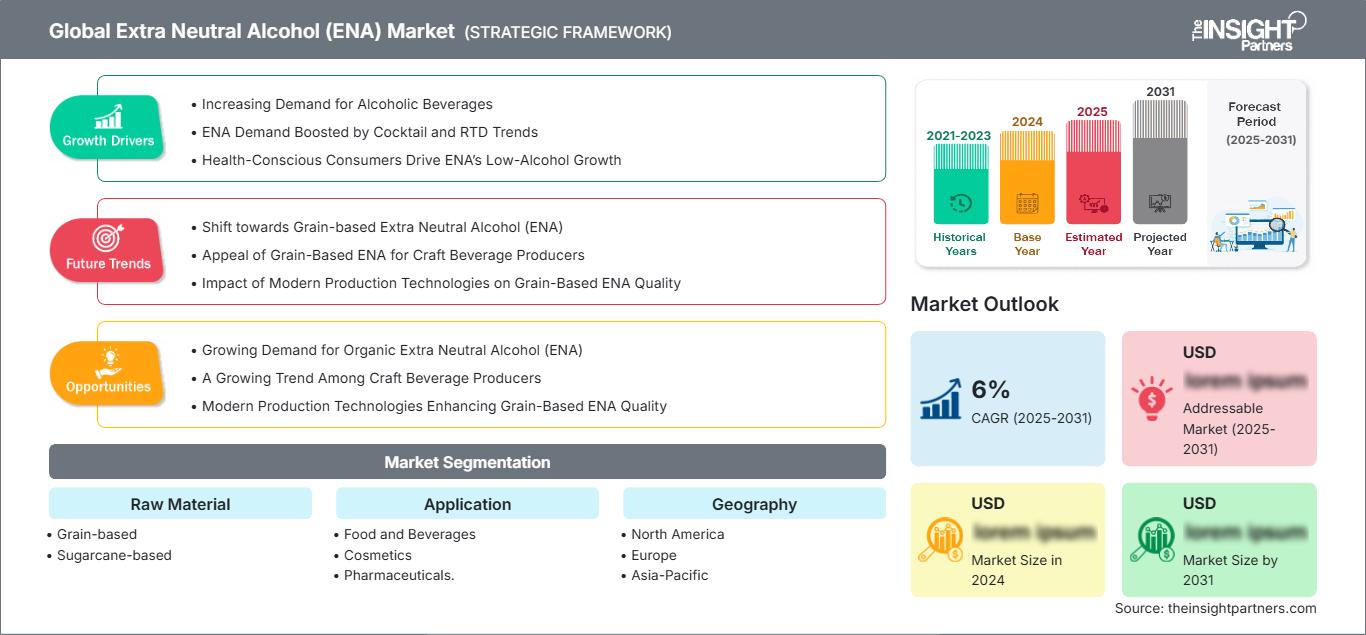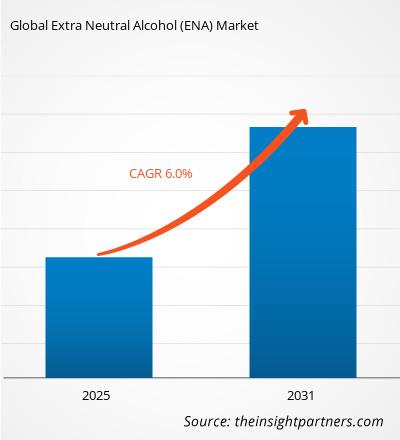Se espera que el mercado de alcohol extra neutro (ENA) registre una CAGR del 6 % entre 2025 y 2031, con un tamaño de mercado que se expandirá de US$ XX millones en 2024 a US$ XX millones en 2031.
El informe está segmentado por materia prima (grano, caña de azúcar y otros). Según la aplicación, se segmenta en (alimentos y bebidas, cosméticos, productos farmacéuticos y otros). El análisis global se desglosa a nivel regional y por países principales. El informe ofrece el valor en USD para el análisis y los segmentos mencionados.
Propósito del Informe
El informe "Mercado de Alcohol Extra Neutro (ENA)" de The Insight Partners busca describir el panorama actual y el crecimiento futuro, los principales factores impulsores, los desafíos y las oportunidades. Esto proporcionará información a diversas partes interesadas del negocio, como:
- Proveedores/fabricantes de tecnología: Para comprender la dinámica cambiante del mercado y conocer las oportunidades potenciales de crecimiento, lo que les permitirá tomar decisiones estratégicas informadas.
- Inversores: Realizar un análisis exhaustivo de tendencias respecto a la tasa de crecimiento del mercado, las proyecciones financieras del mercado y las oportunidades que existen en toda la cadena de valor.
- Órganos reguladores: Regular las políticas y las actividades policiales en el mercado con el objetivo de minimizar el abuso, preservar la confianza de los inversores y defender la integridad y estabilidad del mercado.
Segmentación del mercado de alcohol extra neutro (ENA)
Materia prima
- A base de granos
- A base de caña de azúcar
Solicitud
- Alimentos y bebidas
- Productos cosméticos
- Productos farmacéuticos.
Obtendrá personalización en cualquier informe, sin cargo, incluidas partes de este informe o análisis a nivel de país, paquete de datos de Excel, así como también grandes ofertas y descuentos para empresas emergentes y universidades.
Mercado global de alcohol extra neutro (ENA): Perspectivas estratégicas

-
Obtenga las principales tendencias clave del mercado de este informe.Esta muestra GRATUITA incluirá análisis de datos, desde tendencias del mercado hasta estimaciones y pronósticos.
Factores que impulsan el crecimiento del mercado del alcohol extra neutro (ENA)
- Demanda creciente de bebidas alcohólicas: La fuerte demanda de bebidas alcohólicas sigue siendo un factor clave para el crecimiento del mercado del alcohol extraneutro (ENA). El ENA es una forma muy pura de etanol y es el ingrediente clave en la elaboración de numerosos licores. A medida que los consumidores diversifican sus preferencias por bebidas premium y artesanales, la demanda de ENA de alta calidad continúa creciendo con fuerza.
- Demanda de ENA impulsada por las tendencias de cócteles y bebidas listas para beber: El crecimiento de ENA se ve impulsado aún más por la popularidad de los cócteles y las bebidas listas para beber. Estos productos requieren una base alcohólica premium para disfrutarlos y satisfacer a los consumidores, lo que genera una mayor demanda. La demanda de ENA seguirá aumentando porque los bares y restaurantes seguirán estas tendencias.
- Los consumidores preocupados por la salud impulsan el crecimiento de las bebidas bajas en alcohol en ENA: Los consumidores cada vez más preocupados por la salud impulsan el consumo de bebidas, y las alternativas bajas en alcohol y sin alcohol cobran cada vez más importancia. Las formulaciones de ENA ofrecen una flexibilidad que podría constituir una amplia base para una gama de productos. Actualmente, comienzan a surgir oportunidades de diversificación en el mercado de bebidas alcohólicas para los productores de ENA.
Tendencias futuras del mercado del alcohol extra neutro (ENA)
- Cambio hacia el alcohol extra neutro (ENA) a base de cereales: La tendencia hacia el alcohol extra neutro a base de cereales se está convirtiendo en una tendencia cada vez más común en el mercado de ENA. Los ENA a base de cereales, originarios de cultivos como el maíz y el trigo, han surgido principalmente como una opción más ecológica y sostenible. Esta tendencia sigue las tendencias de los consumidores con sus productos "verdes" e impulsa la expansión del mercado.
- Atractivo del ENA a base de granos para los productores de bebidas artesanales: El ENA a base de granos, además, ofrece un perfil de sabor diferente que resulta atractivo para los productores de bebidas artesanales. Estos productores de cócteles y licores artesanales buscan las mejores fuentes de ingredientes en función de los mercados en crecimiento. La creciente demanda de este ingrediente contribuye a la base del ENA a base de granos, lo que refleja el cambio en las preferencias del consumidor.
- Impacto de las tecnologías de producción modernas en la calidad del ENA a base de granos: Además, las tecnologías de producción modernas hacen que el ENA a base de granos sea más eficiente y de mejor calidad. La purificación del alcohol mediante técnicas avanzadas de destilación es fundamental para las bebidas de alta gama. La creciente adopción de estas innovaciones en la producción impulsará la creciente demanda de ENA a base de granos de alta gama.
Oportunidades de mercado del alcohol extra neutro (ENA)
- Creciente demanda de alcohol extra neutro (ENA) orgánico: La tendencia hacia el alcohol extra neutro a base de cereales se está convirtiendo en una tendencia cada vez más común en el mercado de ENA. Estos ENA, originarios de cultivos como el maíz y el trigo, han surgido principalmente como una opción más ecológica y sostenible. Esta tendencia sigue las tendencias de los consumidores con sus productos "verdes" e impulsa la expansión del mercado.
- Una tendencia creciente entre los productores de bebidas artesanales: El ENA a base de granos ofrece además un perfil de sabor diferente, atractivo para los productores de bebidas artesanales. Estos productores de cócteles y licores artesanales buscan las mejores fuentes de ingredientes en función de los mercados en crecimiento. La creciente demanda de este ingrediente contribuye a la base del ENA a base de granos, lo que refleja el cambio en las preferencias del consumidor.
- Tecnologías de producción modernas que mejoran la calidad del ENA a base de granos: Además, las tecnologías de producción modernas hacen que el ENA a base de granos sea más eficiente y de mejor calidad. La purificación del alcohol mediante técnicas avanzadas de destilación es fundamental para las bebidas de alta gama. La creciente demanda de ENA a base de granos de alta gama se verá impulsada por la mayor adopción de estas innovaciones en la producción.
Perspectivas regionales del mercado global de alcohol extra neutro (ENA)
Los analistas de The Insight Partners han explicado detalladamente las tendencias regionales y los factores que influyen en el mercado global de alcohol extra neutro (ENA) durante el período de pronóstico. Esta sección también analiza los segmentos y la geografía del mercado global de alcohol extra neutro (ENA) en Norteamérica, Europa, Asia Pacífico, Oriente Medio y África, y Sudamérica y Centroamérica.
Alcance del informe de mercado global de alcohol extra neutro (ENA)
| Atributo del informe | Detalles |
|---|---|
| Tamaño del mercado en 2024 | US$ XX millones |
| Tamaño del mercado en 2031 | US$ XX millones |
| CAGR global (2025-2031) | 6% |
| Datos históricos | 2021-2023 |
| Período de pronóstico | 2025-2031 |
| Segmentos cubiertos |
Por materia prima
|
| Regiones y países cubiertos |
América del norte
|
| Líderes del mercado y perfiles de empresas clave |
|
Densidad de actores del mercado global de alcohol extra neutro (ENA): comprensión de su impacto en la dinámica empresarial
El mercado global de alcohol extra neutro (ENA) está creciendo rápidamente, impulsado por la creciente demanda del consumidor final debido a factores como la evolución de las preferencias de los consumidores, los avances tecnológicos y un mayor conocimiento de los beneficios del producto. A medida que aumenta la demanda, las empresas amplían su oferta, innovan para satisfacer las necesidades de los consumidores y aprovechan las tendencias emergentes, lo que impulsa aún más el crecimiento del mercado.

- Obtenga una descripción general de los principales actores clave del mercado global de alcohol extra neutro (ENA)
Puntos clave de venta
- Cobertura integral: el informe cubre de manera integral el análisis de productos, servicios, tipos y usuarios finales del mercado de alcohol extra neutro (ENA), proporcionando un panorama holístico.
- Análisis de expertos: el informe se compila con base en el conocimiento profundo de expertos y analistas de la industria.
- Información actualizada: El informe asegura relevancia comercial debido a su cobertura de información reciente y tendencias de datos.
- Opciones de personalización: este informe se puede personalizar para satisfacer los requisitos específicos del cliente y adaptarse adecuadamente a las estrategias comerciales.
Por lo tanto, el informe de investigación sobre el mercado del alcohol extra neutro (ENA) puede ayudar a descifrar y comprender el panorama de la industria y sus perspectivas de crecimiento. Si bien existen algunas preocupaciones válidas, las ventajas generales de este informe tienden a superar las desventajas.
- Análisis histórico (2 años), año base, pronóstico (7 años) con CAGR
- Análisis PEST y FODA
- Tamaño del mercado, valor/volumen: global, regional y nacional
- Industria y panorama competitivo
- Conjunto de datos de Excel
Informes recientes
Testimonios
Razón para comprar
- Toma de decisiones informada
- Comprensión de la dinámica del mercado
- Análisis competitivo
- Información sobre clientes
- Pronósticos del mercado
- Mitigación de riesgos
- Planificación estratégica
- Justificación de la inversión
- Identificación de mercados emergentes
- Mejora de las estrategias de marketing
- Impulso de la eficiencia operativa
- Alineación con las tendencias regulatorias






















 Obtenga una muestra gratuita para - Mercado mundial de alcohol extra neutro (ENA)
Obtenga una muestra gratuita para - Mercado mundial de alcohol extra neutro (ENA)